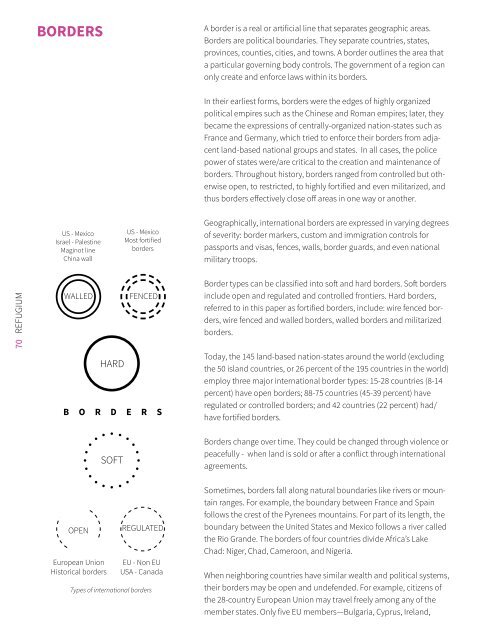Create successful ePaper yourself
Turn your PDF publications into a flip-book with our unique Google optimized e-Paper software.
BORDERS<br />
A border is a real or artificial line that separates geographic areas.<br />
Borders are political boundaries. They separate countries, states,<br />
provinces, counties, cities, and towns. A border outlines the area that<br />
a particular governing body controls. The government of a region can<br />
only create and enforce laws within its borders.<br />
In their earliest forms, borders were the edges of highly organized<br />
political empires such as the Chinese and Roman empires; later, they<br />
became the expressions of centrally-organized nation-states such as<br />
France and Germany, which tried to enforce their borders from adjacent<br />
land-based national groups and states. In all cases, the police<br />
power of states were/are critical to the creation and maintenance of<br />
borders. Throughout history, borders ranged from controlled but otherwise<br />
open, to restricted, to highly fortified and even militarized, and<br />
thus borders effectively close off areas in one way or another.<br />
US - Mexico<br />
Israel - Palestine<br />
Maginot line<br />
China wall<br />
US - Mexico<br />
Most fortified<br />
borders<br />
Geographically, international borders are expressed in varying degrees<br />
of severity: border markers, custom and immigration controls for<br />
passports and visas, fences, walls, border guards, and even national<br />
military troops.<br />
70 REFUGIUM<br />
WALLED<br />
FENCED<br />
HARD<br />
B O R D E R S<br />
Border types can be classified into soft and hard borders. Soft borders<br />
include open and regulated and controlled frontiers. Hard borders,<br />
referred to in this paper as fortified borders, include: wire fenced borders,<br />
wire fenced and walled borders, walled borders and militarized<br />
borders.<br />
Today, the 145 land-based nation-states around the world (excluding<br />
the 50 island countries, or 26 percent of the 195 countries in the world)<br />
employ three major international border types: 15-28 countries (8-14<br />
percent) have open borders; 88-75 countries (45-39 percent) have<br />
regulated or controlled borders; and 42 countries (22 percent) had/<br />
have fortified borders.<br />
SOFT<br />
Borders change over time. They could be changed through violence or<br />
peacefully - when land is sold or after a conflict through international<br />
agreements.<br />
OPEN<br />
European Union<br />
Historical borders<br />
REGULATED<br />
EU - Non EU<br />
USA - Canada<br />
Types of international borders<br />
Sometimes, borders fall along natural boundaries like rivers or mountain<br />
ranges. For example, the boundary between France and Spain<br />
follows the crest of the Pyrenees mountains. For part of its length, the<br />
boundary between the United States and Mexico follows a river called<br />
the Rio Grande. The borders of four countries divide Africa’s Lake<br />
Chad: Niger, Chad, Cameroon, and Nigeria.<br />
When neighboring countries have similar wealth and political systems,<br />
their borders may be open and undefended. For example, citizens of<br />
the 28-country European Union may travel freely among any of the<br />
member states. Only five EU members—Bulgaria, Cyprus, Ireland,




